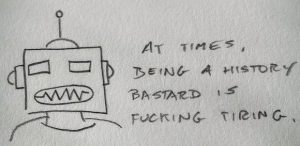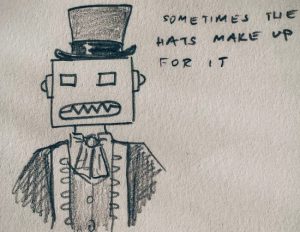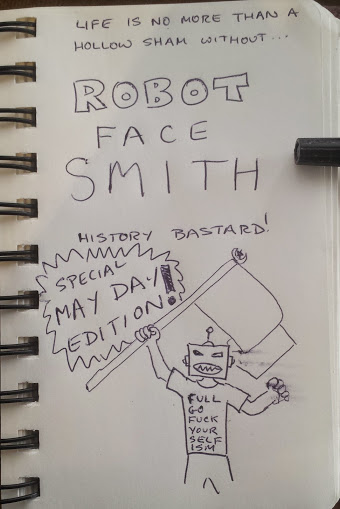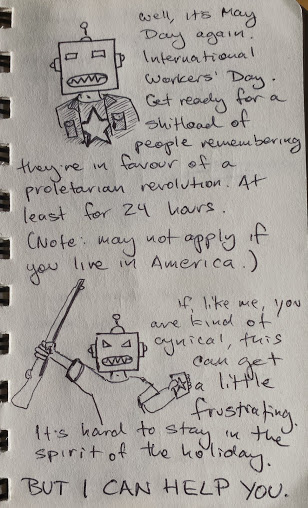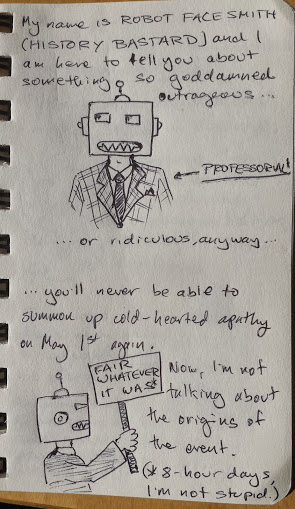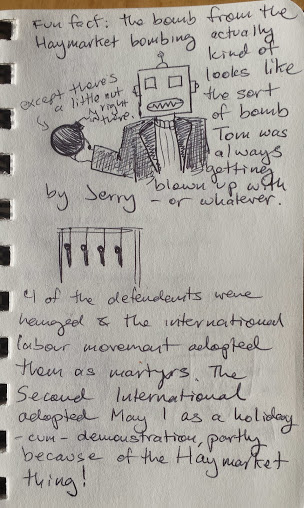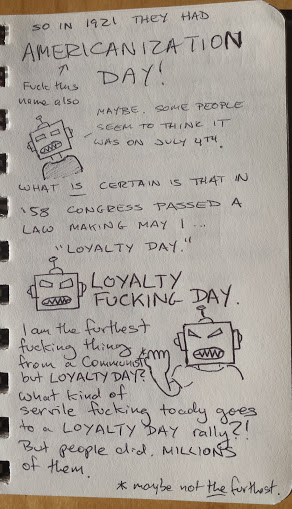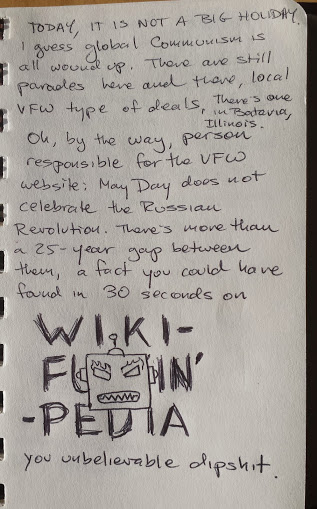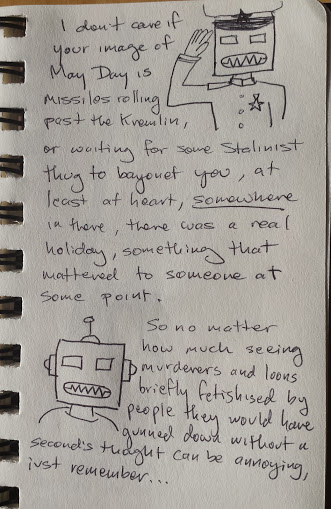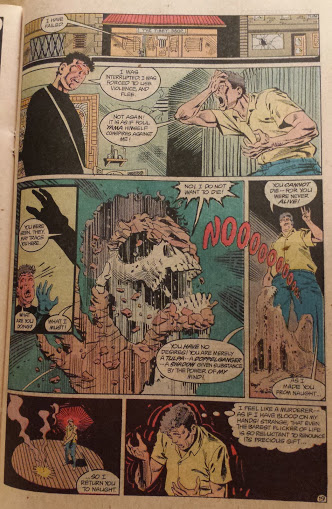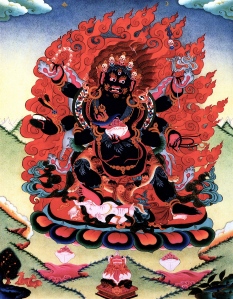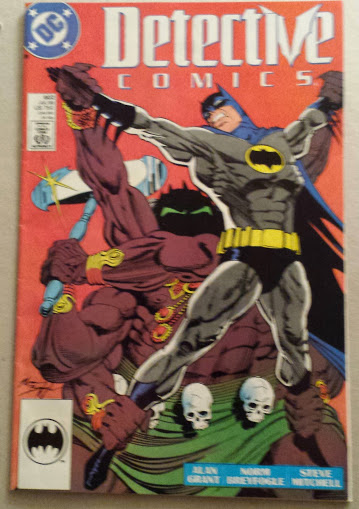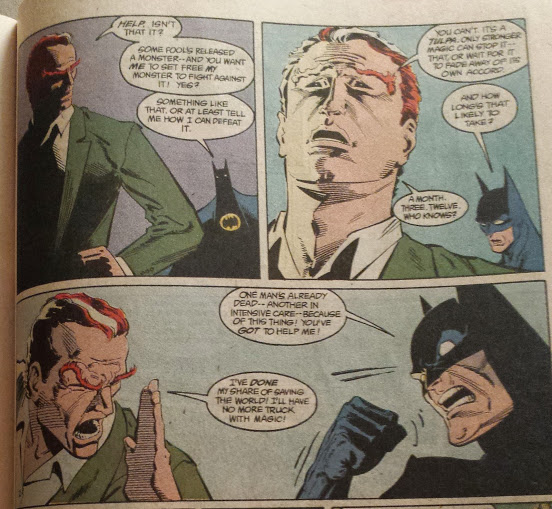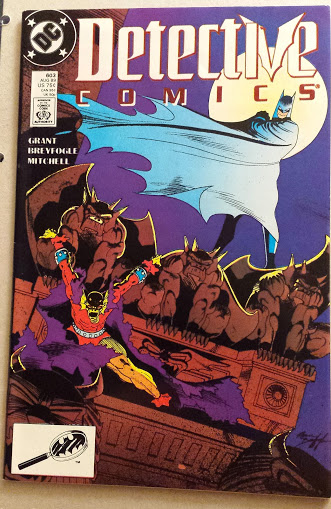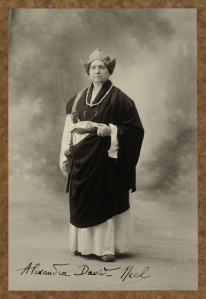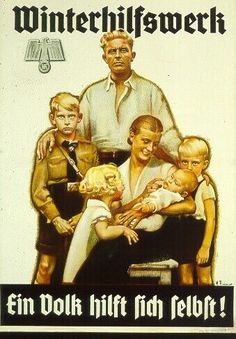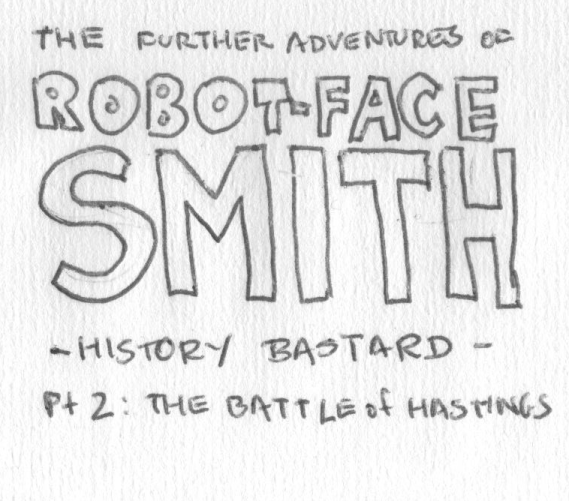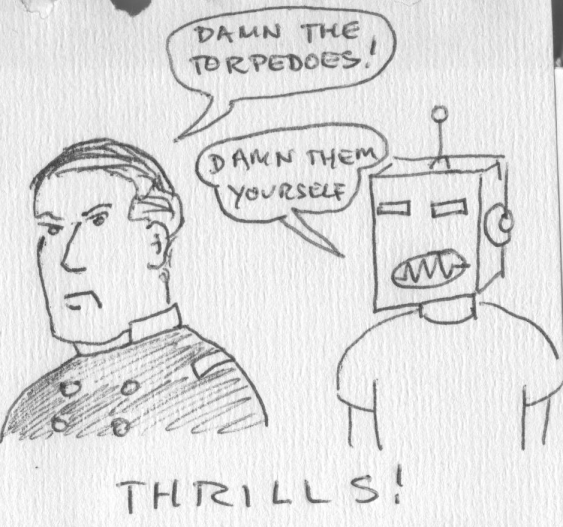comics
Robot Face Smith: Holidayish Special!
I’m not making this up, like I said. Loyalty Day! Pro tip: when someone says there are parades in communities like Batavia, that means they don’t have anywhere more exciting than Batavia to talk about.
Ah, I dunno. People want to have a parade, they went to celebrate the military, that’s cool; they should do whatever they want. It just irks me that millions of people turned out back in the day for that shit.
Comics! Again, possibly.
The other day I received some cool little mini-comics! They are by Gabriel Moshenska, and they’re about female archaeologists, a subject lately given some well-deserved attention by the tireless team over at Trowelblazers. Seriously, if you’re at all interested in the history of the field (or geology or palaeontology) you owe it to yourself to check out the work they’re doing.
Anyway, the comics! They came in the form of A4 sheets with eight colour panels on them.
Then you apply a set of instructions (I struggled at first to figure out which direction the folds go, but on the other hand I’m not too bright about these things):
Once you have folded and snipped, they look like this:
They are pretty adorable — and educational too!
In addition to the Margaret Murray and Elizabeth Pettigrew ones, I also got:
These are pretty neat, and I like the punkity-rock DIY vibe of the minicomics. Maybe I should do some for my own sensational character! Fame and fortune await.
Anyway, I’m not wholly sure what the mechanism is for you to get more of these, but you can read the Pettigrew and Caton Thompson ones online.
Batman, Buddhism, and the trajectory of pop ideas
In a previous post I mentioned going to a talk by Ian “Cat” Vincent at Treadwell’s Books about popular culture and occultism. During this talk, he mentioned a point about the idea of the tulpa in Tibetan Buddhism, a point I’ll return to later, and I mentioned that there was actually a Batman villain in the late 1980s who was a tulpa. I mentioned it briefly in the last post, but yesterday I found 20 issues of the Grant/Breyfogle run on Detective Comics for a quarter each, so now I can talk about it in a little more detail.
Our story runs from Detective Comics 601 to 603 and, as I mentioned before, is written by Alan Grant, pencilled by Norm Breyfogle and inked by Steve Mitchell. In it, we start out with a mysterious robbery committed by a young man who crumbles to bits when Batman catches him. Later, an identical-looking young man tries to rob Wayne Manor. Batman investigates and discovers that these are tulpas or thought-projections sent out by Tenzin, a young Tibetan man who is desperate for money to repay the gangsters his father owed $5,000 to.
Worried that the gangsters are going to kill him, Tenzin creates yet another tulpa, drawing on his own anger and resentment at the criminals and gives it the form of Mahakala, the protector of the faith. Mahakala is an emanation or projection of the Bodhisattva Avalokitesvara who has a frightening, demon-like appearance but is actually a good guy (a letter in the letter column of issue 604, complaining about the comics’ misrepresentation of Tibetan Buddhism, points out that in this respect Mahakala is actually similar to Batman). However, the comic is quick to point out that this is not the Mahakala, but merely a physical representation of Tensin’s negative emotions in the form of Mahakala.
This is comics, of course, so Mahakala gets a slight redesign, complete with a bitchin’ huge axe.
Anyway, the gangsters shoot Tenzin, then run off, pursued by Mahakala, while Batman tends to the injured youth. Cue a load of Batman running around Gotham trying to stop the crooks from being murdered by the tulpa. Since this is a mystical matter, Bats tries to enlist the help of Jason Blood, the human host of the Demon, Etrigan, but Blood, who as we all know hates Etrigan, is having none of it. Breyfogle gets to draw some angry-ass Batman eyes.
Blood’s psychic sidekick Randu goes along with Batman, though. Batman hits Mahakala with a wrecking ball.
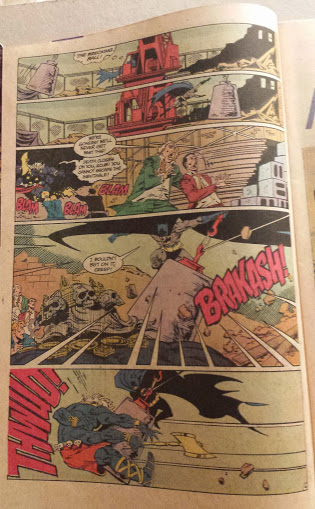
But the tulpa ain’t dead, and when Randu gets in trouble, Blood has to overcome his reservations and intervene as Etrigan. Grant loves writing Etrigan and Breyfogle draws the hell out of him, so this is pretty good news.
Anyway, Etrigan takes out the tulpa, then decides he’s going to kill the gangsters, but Batman tries to intervene. Etrigan whups him too, but then lets him win in one of his fits of demonic whimsy. The End.
So, other than that I got a chunk of my childhood for $5.00, which is a pretty great deal at today’s prices, what’s the relevance of this story? I think the point that Vincent was making in his talk was that the popular conception of a tulpa, shared by occultists and comic fans alike, is of a sort of physical manifestation of a concept, and that this conception originally derives from the work of Alexandra David-Neel.
However, David-Neel’s description of the tulpa seems to be not quite right in Buddhist terms; they’re not really imagined going around smashing stuff and cutting off one of Batman’s ears with a big damn bronze axe. Instead, they’re a sort of tool for thinking about things, and it’s all much more complicated, which may make for great meditative practices but not such good comics. I know next to nothing about Buddhism, so I’ve read this big summary of what a tulpa actually is, but I’m afraid I’ve just come away with “not like in the book; much more complicated.” If I’ve got a detail wrong, please forgive me.
But that’s always the way: the reality of a cultural or religious practice is always much more complicated than the summary of it — just look at the difference between the popular conception and actual practice of “selling indulgences,” for instance — but it’s the popular conception that stays with you. These ideas take on a life of their own, regardless of the original intent, and often outlast their originators.
I seriously didn’t intend for that paragraph to say that Alexandra David-Neel’s interpretation of the tulpa is kind of like a tulpa, but it’s worked out that way a bit, hasn’t it?
Anyway, I just thought I’d expand on a point of trivia from an earlier post at great length because I do like talking about Batman.
Additional:
On a sadder note, the artist who drew this issue and so many other great comics, Norm Breyfogle, recently suffered a stroke, leaving him partly paralysed, including his dominant left hand. A fundraiser raised $100,000 to cover his medical bills, but sadly that’s only half of the needed total (my non-US readers are reminded to be appreciative of our health care systems). However, apparently the Hero Initiative are also getting involved, and DC Comics are releasing a hardcover of his work earlier than scheduled. Breyfogle is posting messages to Facebook and seems to be on the path to recovery, so that’s all good news. But this just demonstrates how precarious the existence of an artist can be; that’s why the work of the Hero Initiative and others is so important.
Pirates, comics, and historical fiction fads
Check out this exciting new vidya technology!
Show Notes
I am a big fan of The works of Larry Gonick. See my previous post on the topic.
The first volume of Age of Bronze is a good place to get started. I wrote about it in an earlier post.
I got my copy of Escape Velocity at Comix Experience in San Francisco.
Check out Archaeological Oddities.
The Nazi Vixen Thing
(Note to readers for whom it matters: this post contains Nazi imagery. It’s used in a … historical? … context but if you don’t like that stuff or are worried about your employer or whatever, I thought I should warn you.)
A while back, reader Ian asked me to write about the whole “sexy Nazi” thing. He probably thought I forgot! I wish I had.
In any event: if you are at all familiar with any sort of modern pulp literature or games surrounding WWII, particularly “Weird War 2” type stuff, you will have been exposed to the “sexy Nazi vixen” archetype. It is … weird.
First, let me establish what I mean here. I’m not talking about a glamorous femme fatale who happens to be a Nazi, like this lady:
Or Dr Elsa Schneider in Indiana Jones and the Last Crusade:
Those two are perfectly ordinary examples of the pulp femme fatale archetype and could be subbed in for any old bad guy (although I guess Schneider looks all icily Nordic, so there’s that).
No, I’m talking about stuff like this:
Or this:
Or these miniatures for the game Projekt X (bonus points for having both the bondage-gear and inexplicable-decolletage-SS-uniform variants).
So: what the hell?
Now, the first thing that occurred to me was that this is a feature of pulp art, and could it in fact be a legacy of the pulp era? The answer seeeems to be that it isn’t. I haven’t conducted a thorough search, but I don’t see a lot of sexualised German uniforms, sexualised Nazi regalia, anything like that, in contemporary pulps or comics. The closest thing that popped out at me (hurr) is Valkyrie, seen above with unconscious Airboy. Now, while that’s a modern illustration (by the late Dave Stevens), it’s a pretty accurate rendition of Valkyrie’s 40s-era costume. However, you’ll note that there’s not actually anything particularly German about her uniform — even Airboy is in bright American red and blue, but she’s just in generic sexy villainess garb. (And if Airboy and Valkyrie remind you of Jetlad and Skywitch from Top 10: yup.)
But it isn’t until after the war that we get the traditional Nazi sex vixen. I think that in order to be a proper pop-culture Nazi vixen, you need some or all of the following:
- An absurdly tight German uniform OR bondage gear festooned with Nazi insignia
- A great big officer’s hat OR a jaunty little cap (almost never a stahlhelm)
- High-heeled bitch boots OR jackboots
- A riding crop
- A gun: usually a Luger, an MP40 or something ludicrous like an MG34. Not a 98K.

Now, the archetypal example of this character is:
The jaunty-capped ice maiden types in the background just round out the definition.
Apparently, this kind of quasi-porn started almost immediately after the war, I guess because it gave the usual low-budget slimeballs the kind of “educational” pretext they needed to wrap their movies in a veneer of social responsibility (especially important for the US, where most of them failed to pass anyway but whatever).
But from there somehow it seems to have crept into popular culture in a way that lots of similar stuff didn’t. Here’s an example from Return to Castle Wolfenstein, which is pretty mainstream:
I guess, in the end, the answer to “is it just a bondage thing?” is “yes.” It’s notable that there isn’t any comparable super-sexification of the other combatants — oh sure, there’s lots of bomber nose art and glamour art and pinups, but they don’t have the same cultural oomph as the Nazi Vixen.
What’s extra weird to me is that of course this is about as un-Nazi as you can get. I mean, sure, obviously the Nazis were into horrific torture and oppression, but their attitude toward women was not quite so decadent. Nazism rejected the idea of the modern “liberated” woman, and the party tried (with very little success) to force women out of the workforce and back into the home, where they would be smiley (or sometimes stern) and blonde and look after smiley or stern blonde children.
I mean, in a way it’s just indicative of how far WWII gamers have replaced the specific beliefs of the German government with a sort of expression of generic evil (evil overlords require sexy evil female sidekicks), but still.
As you probably know, the USSR had quite a lot of women fighting. Female snipers are famous, of course, but there were female pilots, female tank commanders, female military police, the whole bit. And yet those are seldom (sometimes, but not as often) as ridiculously sexualised as German women. Is it because Soviet women actually fought? Is it because Nazis have that whole “torture camp” thing going on? I honestly have no idea.
So, to summarise: the roots of the “Nazi sex vixen” thing? Porno, as far as I can tell. Its modern incarnation: maybe goofy and harmless, maybe weird and creepy.
As an aside: Valkyrie eventually switched sides and became a good guy; Secrets of the Third Reich has a female American super-soldier in a tank top and implausibly short shorts.
Hey Kids! Comics!
This past weekend my wife and I went to the Comics Unmasked exhibit at the British Library. It was pretty good, but somehow it left me feeling a little unfulfilled. 
Let me put my cards on the table here: I like my comics pretty mainstream, with the notable exception of Age of Bronze. I am a superheroes guy, broadly speaking. Nothing against the underground stuff, but that is what I seem to have wound up liking and I’m OK with that. I don’t love ’em uncritically, of course — I don’t do anything uncritically, as you may have noticed. But I think that the fairly widespread attitude of rejecting cape comics as “mainstream” or “conventional” or whatever is completely misguided. A Kirby issue of Fantastic Four has more non-mainstream content in it — in the form of weird, brainbending Kirbyness — than nine out of ten earnest, diary-style comics. Now, that may not be true of an issue of New 52 Justice League, but I’m just pointing out that while there’s a lot of garbage in there, I think it’s a big mistake to write off the genre.
And the impression I sort of got from this exhibit was a little bit like the one I got from the BL’s science fiction exhibit — that when they have this geeky material, they sort of handle it with tongs? I don’t know. Anyway, let me recount my experience.
So you walk into the exhibition room, which is this usual hushed, dimly lit sort of space, and there are the usual glass cases full of open books, such as you might find in any British Library exhibition. And there are also these mannequins in men’s clothes and Guy Fawkes masks standing around in packs and one or two other cool pieces of art here and there. The exhibit is divided up into various sort of zones — you proceed through the zones pretty linearly, but within them you can wander around and look at stuff. There are some tablets with comics on them attached to the benches, which I thought was cool, and there are some computers with interactive stuff near the end, which I didn’t really look at. Most of the zones are just exhibit spaces, but there’s one set up as a little artist’s studio where you can add your drawing to the ones other people have done and one that’s like a little faux office/studio space with reference works and stuff.
The zones are divided up thematically: there’s one on identity, one on politics, one on sex, etc.
OK, the good stuff:
- It is the British Library, so they have everything. Little underground publications, typescripts, weird unpublishable 3D comics, super-collectible stuff, whatever. They’ve even got a Renaissance “pauper’s bible,” one of those brightly illustrated collections of Bible stories. It’s pretty cool. (I don’t think it’s that actual one, but you get the idea.)
- They cast their nets wide in tracing the influences of comics — there’s a big spread-out front page of the Illustrated Police News (a Jack the Ripper headline), for instance. They’ve also got illustrated ballad sheets, children’s picture books, political cartoons, and so on and so on, to really give you a full grounding in the “illustrated trash literature” genre that comics grow out of. It’s thorough and it’s informative.
- They nail some of the key things that are particularly British in British comics and that have since become standard in American comics, such as the kind of wry, cynical attitude toward violence (although you could argue that this actually existed in US comics but was just suppressed … what do I know?).
What’s not great about it?
- One of the problems with British Library exhibitions in general is that people tend to spend a longer time reading a book than they would looking at a vase or something. This isn’t so bad when what you’re just looking at a medieval Bible or a Chinese scroll or something, but when it’s an Oor Wullie strip and it’s in English (or Scots in this case) people will stop and try to read it. And what this means is that if there are a lot of people in the exhibit, it can turn into one long line just veeeeeery gradually shuffling along in front of the display cases.
- The thematic division is interesting, but it felt broken up to me. Maybe it’s just that I would have preferred to see it done chronologically, but it felt weird and bitty to me, and I felt like it obscured the connections between things rather than highlighting them.
- It really lacked American comics. Now I know that this is the British library and they have British things, but I don’t think I saw anything (or barely anything) from Marvel UK, for instance. I just think that from the war onwards you can’t really understand what’s happening in British comics unless you see where the US influences are pushing them and how they’re responding to them.
I also thought there was a bunch of predictable silliness. Like, they show a two-page spread from “Whatever Happened to the Man of Tomorrow?” and the sign says, I don’t know, something like “we see Superman confronting his own mortality, exemplified by this panel of him sitting on a bed crying.” Now I know that (hat tip to Chris Sims) it is impossible for DC comics not to try to create cheap pathos by having Superman cry, but what I can’t understand is why the card doesn’t say “we see Superman confronting his own mortality, embracing it as part of his humanity and settling down to raise a child with his beloved Lois in anonymous old age” since that is what happens literally on the very next page.
For Pete’s sake. I don’t think I saw the phrase “grim and gritty” at any point, but there were parts of it that were remarkably like the 1990s. And I’m not talking about the good Grant-Morrison-JLA 90s either.
Oh, and there was a display of HP Lovecraft paperbacks, because Lovecraft influenced British comics writers. Which of course he did — although not as much as they claim he did; they’re using “Lovecraft” to stand in for “spooky occult shit” — but if HPL gets in, why doesn’t Jack Kirby? Or Alex Raymond? Or or or or …
In short, while I think it was an interesting if incomplete look at UK comics as an art form, I think that if you were looking for an exploration of UK comics as a cultural phenomenon I think it was lacking in some ways. I realise Crisis was important, but there must have been half a dozen issues in there, and not one of Commando or Starblazer. I get what they’re trying to say — comics aren’t just for kids, they aren’t just superheroes, look at all this other stuff they have done. And maybe to an audience that’s not as aware of that diversity, that’s fair enough. Maybe all the stuff I took for granted is news to some people.
Enrique Goddamn Alcatena drew for Starblazer.
Things I Like: Age of Bronze
If you like comics and archaeology, and you haven’t at least taken a look at Eric Shanower’s epic Age of Bronze, you’re missing out.
Writer/artist Shanower is telling the story of the Trojan War in comic form, and I mean the whole story — the abduction of Helen, Achilles hiding among the women, Troilus and Cressida. Not just the Iliad, but everything that’s anything to do with the story. It’s an entirely human tale — no gods, although the characters certainly believe in them — and it’s compelling reading.
What’s really exciting to me is the amount of research that Shanower does to bring his Troy to life in honest-to-Schliemann Bronze Age glory. Age of Bronze is one of the only comics I love enough to collect it both in trades and in singles, and every time I’m somewhere with a good comics shop, I look around to fill in the gaps in my collection. The most recent time I was in the US, I picked up several back issues, including this special:
This is the special in which Shanower just talks about the research he did to prepare for the book and the decisions he made (such as basing the Trojans on the Hittite culture). There’s pages of great stuff like this:
I have a lot of time for this. Every issue of the comic also contains a section of literary and archaeological discussion — basically footnotes — in which Shanower goes behind the scenes of the book.
I love this comic a lot. So what’s wrong with it?
Well, the most important problem with Age of Bronze is that it comes out … basically every once in a while. I’ve been collecting it since about 2003 or so, and it hasn’t made it to issue 40 yet. The fighting at Troy has really only just started.
Now, if you want to read this book, all that means is that you should pick it up in trade, rather than trying to follow it “monthly.” The first volume deals with the origins of the war, while the second volume is about the buildup to the conflict and the Iphigenia story. After that, you have the third volume, in which the war actually starts. This is split into part one and part two. You can also pick up the first issues for iOS, with colour and annotations and all kinds of stuff.
Seriously you guys, it is pretty good. You can read my copies if you come to my house, but you can’t borrow them. They are mine.
The return of a fan favourite!
Webcomics stardom here I come
As you know, I spend every day tormented by the thought that new media stardom is just outside my grasp. But finally I think I’ve figured it out. Behold the sensational character find of 2014:
Join that lovable scamp Robot Face Smith as he, I don’t know, meets history dudes or something.
I actually meant to draw Stephen Decatur, but force of habit, you know?
Anyway, what do you think? Some of that webcomics money gonna come my way?
